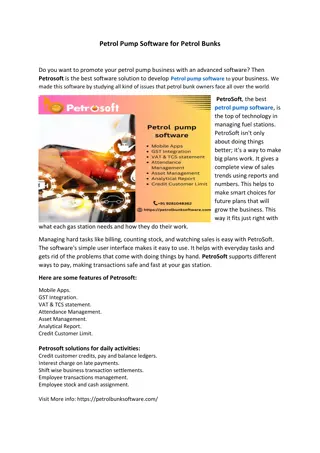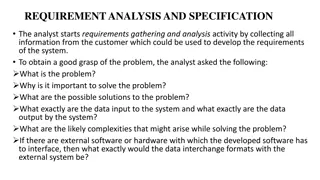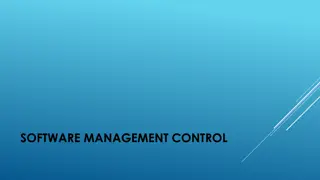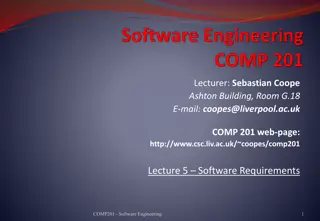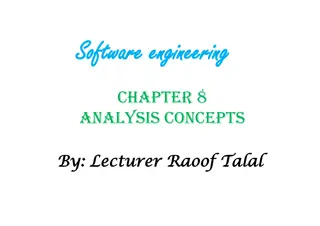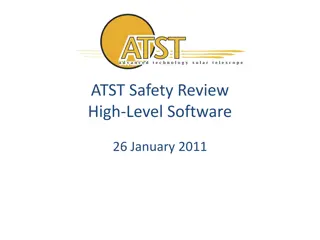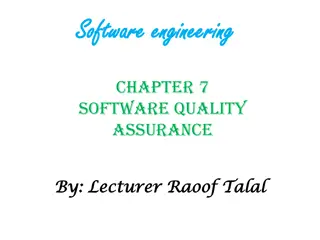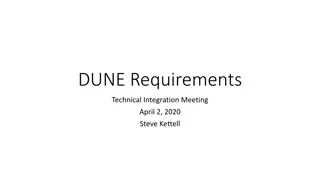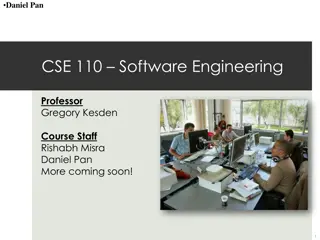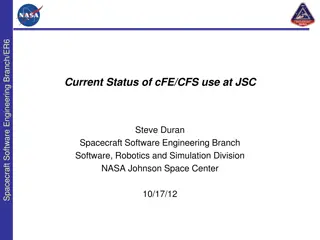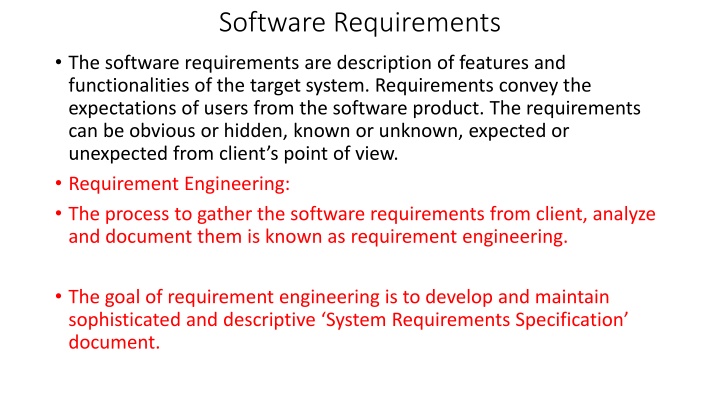
Software Requirements and Requirement Engineering Process
Learn about software requirements, requirement engineering, and the process involved in gathering and documenting requirements for a software project. Explore feasibility studies, requirement gathering, software requirement specification, and validation to ensure successful software development.
Download Presentation

Please find below an Image/Link to download the presentation.
The content on the website is provided AS IS for your information and personal use only. It may not be sold, licensed, or shared on other websites without obtaining consent from the author. If you encounter any issues during the download, it is possible that the publisher has removed the file from their server.
You are allowed to download the files provided on this website for personal or commercial use, subject to the condition that they are used lawfully. All files are the property of their respective owners.
The content on the website is provided AS IS for your information and personal use only. It may not be sold, licensed, or shared on other websites without obtaining consent from the author.
E N D
Presentation Transcript
Software Requirements The software requirements are description of features and functionalities of the target system. Requirements convey the expectations of users from the software product. The requirements can be obvious or hidden, known or unknown, expected or unexpected from client s point of view. Requirement Engineering: The process to gather the software requirements from client, analyze and document them is known as requirement engineering. The goal of requirement engineering is to develop and maintain sophisticated and descriptive System Requirements Specification document.
Requirement Engineering Process It is a four step process, which includes Feasibility Study Requirement Gathering Software Requirement Specification Software Requirement Validation
Feasibility study Feasibility study When the client approaches the organization for getting the desired product developed, it comes up with rough idea about what all functions the software must perform and which all features are expected from the software. Referencing to this information, the analysts does a detailed study about whether the desired system and its functionality are feasible to develop. This feasibility study is focused towards goal of the organization. This study analyzes whether the software product can be practically materialized in terms of implementation, contribution of project to organization, cost constraints and as per values and objectives of the organization. It explores technical aspects of the project and product such as usability, maintainability, productivity and integration ability. The output of this phase should be a feasibility study report that should contain adequate comments and recommendations for management about whether or not the project should be undertaken
Requirement Gathering If the feasibility report is positive towards undertaking the project, next phase starts with gathering requirements from the user. Analysts and engineers communicate with the client and end-users to know their ideas on what the software should provide and which features they want the software to include. Software Requirement Specification SRS is a document created by system analyst after the requirements are collected from various stakeholders. SRS defines how the intended software will interact with hardware, external interfaces, speed of operation, response time of system, portability of software across various platforms, maintainability, speed of recovery after crashing, Security, Quality, Limitations etc. The requirements received from client are written in natural language. It is the responsibility of system analyst to document the requirements in technical language so that they can be comprehended and useful by the software development team.
SRS should come up with following features: User Requirements are expressed in natural language. Technical requirements are expressed in structured language, which is used inside the organization. Design description should be written in Pseudo code. Format of Forms and GUI screen prints. Conditional and mathematical notations for DFDs etc
Software Requirement Validation Software Requirement Validation After requirement specifications are developed, the requirements mentioned in this document are validated. User might ask for illegal, impractical solution or experts may interpret the requirements incorrectly. This results in huge increase in cost if not nipped in the bud. Requirements can be checked against following conditions - If they can be practically implemented If they are valid and as per functionality and domain of software If there are any ambiguities If they are complete If they can be demonstrated


